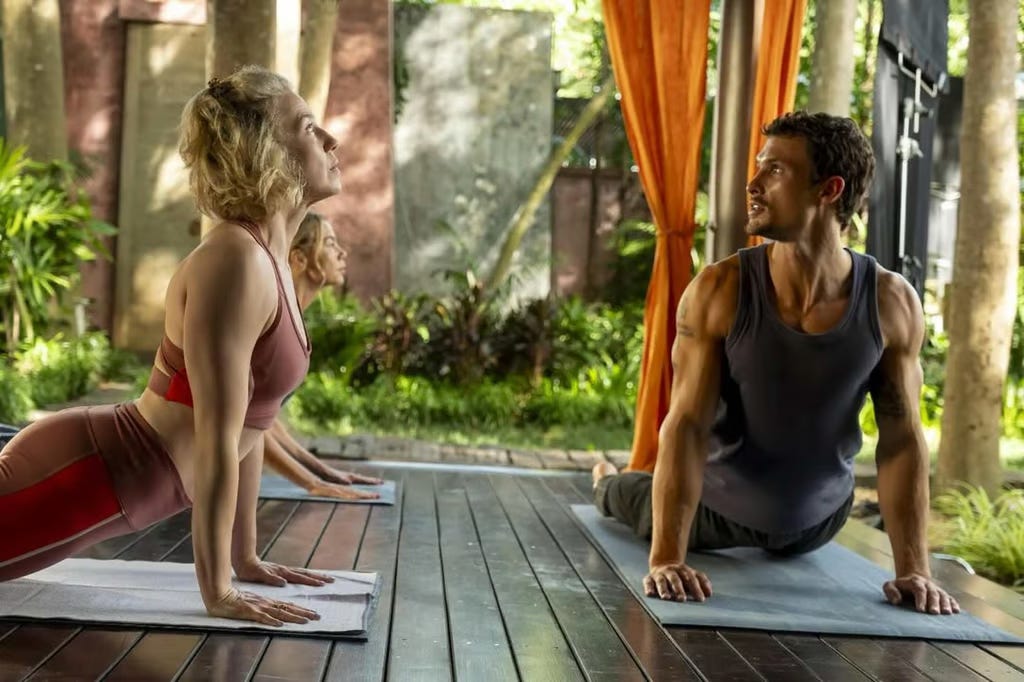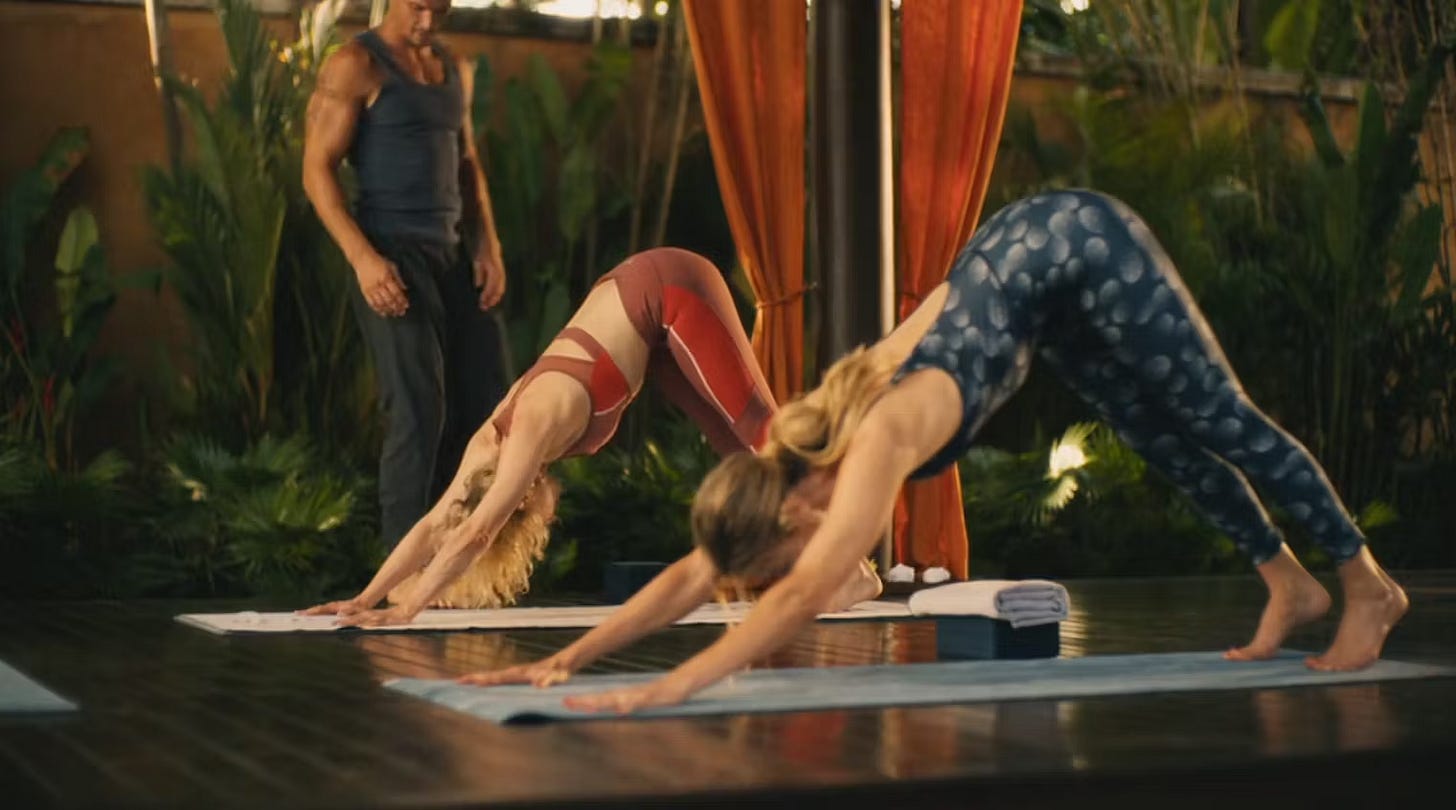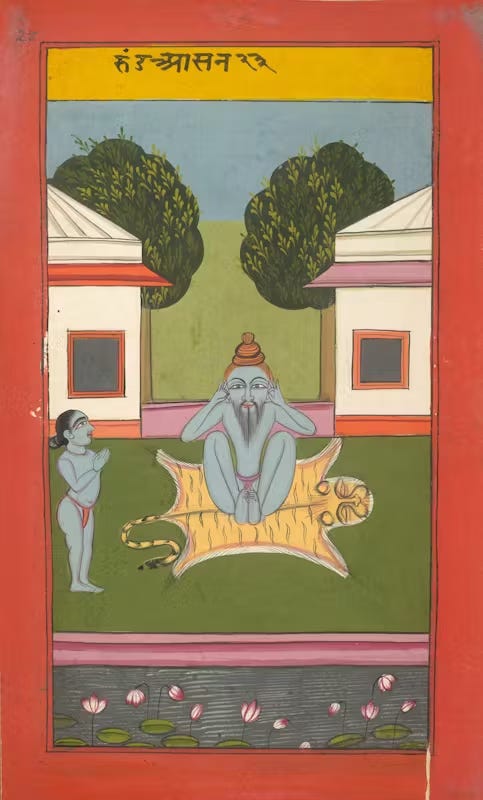If you’re new here, welcome! Silky Crunch is a newsletter about buying better, cuter things. There are links for low-synthetic yoga clothing and plastic-free mats at the end of this letter, if you wanna skip my elementary realizations about the yoga industrial complex.
Two years ago, I noticed cool yoga practitioners wearing looser clothing that doesn’t scream “activewear,” though the trend had probably been around for millenia. Just not at the fast-paced fitness-focused yoga classes around NYC, the kind that promise to “sculpt” and “tone.”
My friend Aria led me to a candlelit yoga class in St. Marks, and gasp, I was the only one wearing skin-tight leggings— known by most Americans as “yoga pants.” The evening felt like time travel to the 90’s: real candles (not battery-powered plastic flickers), tall ceilings, exposed brick walls. Nary a tech bro’s toe in my face.
The yogis around us were wearing more suitable attire: natural fibers, loose-fitting, relaxed and breathable in the crotch area. A chic, grey-haired woman inverted in striped pajamas, while a white man with dreadlocks adjusted his Thai fisherman pants. In our final savasana, the instructor read from a Vedic text.
I felt deeply relaxed, until a startling realization tightened around me… that the various yoga classes I frequented for almost twenty years had all been glamorized stretching routines, with a dash of namaste.

I’ll admit it. I have desired these $128 Pants from ALO Yoga. Every dewy-faced influencer looks effortless in the “buttery soft” polyester, and the “snatched” fit is flattering on friends who show up to pilates in pretty pastels.
A small voice inside of me asks, wouldn’t you enjoy moving your body more if you owned The Yoga Pants? Could be a good investment. If you feel cute, you’ll be more motivated to move your body!
But this spring, I’m here to announce to everyone (including myself) that we don’t need those Yoga Pants. Usually we’d chat about how they’re not cute for your health or our planet, but if you’re here, you already know. So today I’ll whisper… they’re going out of style.
On Yoga Studios
Have you ever participated in a yoga class that didn’t feel like it was run by the synthetic, American yoga industrial complex? My first instructor looked like a lady from this DuckDuckGo search for yoga pants. It was a punishing Bikram class where we were discouraged from leaving, even if we felt faint from the hot mixture of spandex swamp ass and sweaty feet sprinkles in the air.
I’ve also tried yoga classes offered by all-inclusive gyms, like when a Equinox friend shared a guest pass. Taught by a cheerful man with 2% body fat who encouraged dozens of sit-ups, I felt dizzy as if my body and soul were being split instead of united. I was intrigued by his other offering— a high-intensity, yassified Latin dance fitness class that seemed more aligned with his energy.
St. Marks Yoga, on the other hand, is run by a group of yogis who want to share their practice, not maximize profit or expand the chain. I’ve never been back, but as you can tell, I’ve been thinking about them. No shade at other yoga studios or practitioners who teach “fitness” yoga, we could all benefit from yoga in any form.
But personally, I’m not chasing maximum gains from mindful movement. I lift weights for that. Yoga for me is a spiritual and emotional practice, so I don’t want PWR Yoga or Yoga Sculpt. It’s cool that more different types of yoga are accessible to us outside of India though, beyond Hatha Yoga. Have you heard of Kemetic yoga? It’s like yoga poses from Egyptian hieroglyphics. I love that it exists! I’ve also been intrigued by Kundalini yoga, where practitioners wear all white.
There are many kinds of yoga, but “yoga body” is not the one that these billion-dollar brands would have us believe. These bodies clearly built on strength training, running, and pilates are marketed to us as yoga bodies to sell us $128 pants. And the marketing works! I remember signing up for an unlimited month of yoga in 2011 and wondering why my arms weren’t getting ripped from downward dog.
Here’s a quick video from the 2025 International Yoga Festival last month in India. A fun look at what serious yogis wear to yoga:
Lululemon and ALO Yoga
Usually when everyday people engage in physical exercise, we mimic what elite athletes wear. Swimmers splash in speedos. Taekwondoins don cotton dobok. So how did American women begin dropping $128 on skin-tight polyester when yoga leaders have never dressed that way?
Let’s go back to 1998. Lululemon was founded in Vancouver by Chip Wilson, who specifically picked a nonsensical word with three “L”s to be exotic to Japanese buyers. Wilson told Canada’s National Post Business Magazine in 2005: “It’s funny to watch them try and say it.”1
He took his enjoyment of yoga and capitalized on it, and along the way, women all over the world started to wear skin-tight plastic pants that contribute to skin rashes and yeast infections before ending up in a landfill. Our waists looked snatched though! An American success story.2
Now, Lululemon didn’t invent leggings. Americans had been wearing spandex for aerobics and dance, and were used to seeing Olympic athletes in tight performance wear. Yoga was a casual vessel to fill with our desire to wear tights and feel sporty without doing any sports. As The Chicago Tribune pointed out in How America Became a Nation of Yoga Pants, we wanted to be comfortable:
“Yoga, as you might know, had been doing just fine for thousands of years without a stretchy uniform. The rise of yoga pants owes a lot to simple timing. Lululemon appeared on the scene at the tail end of the (perhaps unfortunate) leggings revolution, right about the time longer-term trends were leaning toward more casual dress.”
Americans loved it so much though, that leggings then became known as “Yoga Pants.” Like most millennial women, I’ve worn “yoga pants” running errands, working out, and meeting friends for brunch.
Meanwhile, Lululemon’s Whitespace (now Lululemon Labs after internal backlash) continued to innovate on how they could tap into the emotional, sensory aspects of the human psyche, down to the first “hand feel.”3 We’ve all been there in a store where it’s “omg so soft,” then weep at home as it pills in the dryer.
With more evidence mounting that these pricey pants leach microplastics that we then inhale into our brains, more effort is required from these brands to keep shoppers hooked on the soft, synthetic embrace. Using cheap recycled plastic with names like Softstreme™, there’s budget to spare for marketing campaigns and large percentage kickbacks to influencers.
Men are not immune to Lululemon’s marketing either. Names like Warpstreme™ and Utilitech™ appeal to men with big trucks and nothing to haul around in them. Descriptions like “cotton-canvas like feel with natural texture,” make me lol, you can actually just buy 100% cotton canvas pants with real “natural texture” for literally half the price from L.L. Bean. But then you’d miss out on Lulu’s ABC tech: “Our ABC™(Anti-Ball-Crushing) technology removes tension from the crotch of our pants to unlock your full range of motion.”
The playbook is strikingly similar to the processed food industry’s marketing tactics: develop synthetic additives, colors, crunch, and packaging to keep consumers addicted. We’ve seen it before: the same companies are now coming around to up-charge us x3 on “real” food and “natural” fibers that are synthetic-free.
ALO Yoga now sells 100% cashmere plush waffle pants ($348) and a 100% cashmere Jet Set bra ($150).
According to Morningstar retail analyst David Swartz, “There are a lot of companies out there making leggings out of polyester,” “I think [Alo ] has found a niche of women looking for more premium athleisure apparel.”4
I’m susceptible to marketing and want those pants. While the title of this letter is “you don’t need to buy ALO Yoga pants,” ALO Yoga should send me their natural fiber goodies as they can certainly afford it.
Founded in 2007 by Danny Harris and Marco DeGeorge in LA, the founders are now worth $5 billion each. According to Forbes, the ALO Yoga duo together are worth more than Chip Wilson of Lululemon.
In the two years since candlelit yoga at St. Marks, I’ve tried to avoid that unsettling and constrictive feeling, trying out different outfits like cotton boxers and a mostly cotton sports bra (92% cotton, 8% spandex). I didn’t feel like I was cool enough to rock pajamas pants in class, but I also didn’t want to cosplay what the original yoga gurus were wearing, since 1. it’s not a historical re-enactment and 2. I’m not some elite yogi.
We have yoga pants at home
An easier way to bridge the gap between what I had been conditioned by Lululemon to think of as “yoga wear” and what serious yogis wear were these LA Apparel leggings ($34) I already had at home.
At 95% cotton, 5% spandex, they’re so comfs but WILL NOT make you look snatched. To be honest, your stomach may look bulbous; you’ll need to harness the true power of yoga to let go of such shallow concerns and forget how teeny your waist looked in compressive “yoga pants.”
Once you meditate on how restrictive polyester-nylon-spandex sportswear can be, it feels antithetical to yoga which is at least partially about meditation, breath, and release from physical attachments. Unifying the mind body and soul.
These yoga leggings ($48) feel even more appropriate, but like I said, I’m trying to wear what I have. You can wear what you already have too, but what if you don’t have any workout wear that doesn’t squeeze you like a sausage in its casing? What if you don’t have anything that’s not 98% fossil fuels?
Look at the natural fiber clothing you wear when you’re not working out. What do you wear lounging, meditating, hiking, sleeping?
I once slept over at an Indian friend’s house and in the morning, saw his father crouched over outside, weeding in grey sweatpants and sandals.
“Is your dad doing yard work?”
“No, that’s his morning yoga.”
Ideas for low-plastic yoga wear
BOTTOMS
Last month I splurged on
’s regenerative cotton pants after reading her Substack post. The Pants ($185) are not “yoga pants,” but I plan to wear them for yoga, and hiking too. I wore them on an airplane and kayaking with alligators in Louisiana. While not cheap, they’re sewn from 100% regenerative cotton in India and naturally dyed with minerals.100% cotton, Cottonique drawstring pants for women ($40) and for men ($45)
Unisex Thai fisherman pants ($33)
100% cotton Everyday apartment pants ($69)
The 100% cotton pajama-look pants I wish I could pull off in yoga class ($238)
100% cotton, unisex jersey shorts ($36) I own in brown. No butt sweat will get through in these.
BRAS & TOPS
Nour wears this 100% shrink-free cotton tank ($24). “I like the 6.5oz cotton weight because it’s sturdy and doesn’t droop under my chin during yoga.”
I was gifted this 100% cotton, reversible sports bra ($48) from
. The cotton is a high-quality weave and so comfs, it is now my fave for low-impact movement. None of my other sports bras are 100% natural fibers on the nips. Although the elastic band is not covered with cotton, I would buy this again with my own money. V-neck on one side and scoop neck on the other. Goes up to XL.I like this 95% cotton, 5% spandex crop top ($12-18) for yoga because flowy tops get in my face during cat-cow. Plus, my favorite colors are on sale.
For years, this has been my go-to organic cotton sports bra. 92% cotton, 8% spandex, it is great for high-impact sports but perhaps too tight for yoga.
66% Organic Cotton, 29% Hemp, 5% Spandex hemp sports bra ($44) goes up to 2XL. If you’re spending $100 at Jungmaven, get $20 off your purchase (and I’ll get $20 off too!)
PLASTIC-FREE YOGA MATS (if you don’t have a tiger skin at home)
The natural tree rubber yoga mat is a favorite of yoga instructors at my local Brooklyn studio ($91). Most natural rubber yoga mats contain some synthetic rubber for “durability,” but not this brand.
Machine-washable, cotton and latex yoga mat ($159). Also seems like a good playmat for babies.
Naturally dyed, cotton herbal yoga towels ($39+). I’d love one of these to put over my existing plastic yoga mat!
I love this butterfly cork yoga mat ($99) but after reading about how most cork is held together by plastic, I emailed them and never got a response… they call it “plant-based foam” on their site though.
I have a letter coming up on activewear for high-impact sports, but it’s taking some time. If you have brands/items you rec, please share! Especially if you’ve tried semi-synthetic performance fabric like the Namarie men’s shorts, which seem to have mixed reviews…
Thanks for reading Silky Crunch. It’s so fun that this little letter meant for my small group of friends resonates with folks of all ages.
Silky Crunch may make some cents if you purchase through some of the links above.
In Case You Missed It:
https://www.the-independent.com/life-style/fashion/lululemon-ceo-scandal-controversy-b2473505.html
Wilson is American-Canadian
https://www.chicagotribune.com/2018/10/31/the-rise-of-lululemon-how-america-became-a-nation-of-yoga-pants/
https://www.forbes.com/sites/jemimamcevoy/2025/04/01/the-founders-of-this-lululemon-rival-are-worth-nearly-5-billion-each/
















totally agree. i will say, though, i have found some spiritual yoga teachers at equinox in nyc :) their classes are a lot emptier than the yoga sculpts of the world though lol
I’d want to ditch plastic yoga mats, but i have latex/natural rubber allergy :(